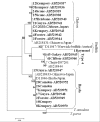Emergence of new types of Theileria orientalis in Australian cattle and possible cause of theileriosis outbreaks
- PMID: 21338493
- PMCID: PMC3050848
- DOI: 10.1186/1756-3305-4-22
Emergence of new types of Theileria orientalis in Australian cattle and possible cause of theileriosis outbreaks
Abstract
Theileria parasites cause a benign infection of cattle in parts of Australia where they are endemic, but have, in recent years, been suspected of being responsible for a number of outbreaks of disease in cattle near the coast of New South Wales. The objective of this study was to identify and characterize the species of Theileria in cattle on six farms in New South Wales where disease outbreaks have occurred, and compare with Theileria from three disease-free farms in Queensland that is endemic for Theileria. Special reference was made to sub-typing of T. orientalis by type-specific PCR and sequencing of the small subunit (SSU) rRNA gene, and sequence analysis of the gene encoding a polymorphic merozoite/piroplasm surface protein (MPSP) that may be under immune selection. Nucleotide sequencing of SSU rRNA and MPSP genes revealed the presence of four Theileria genotypes: T. orientalis (buffeli), T. orientalis (ikeda), T. orientalis (chitose) and T. orientalis type 4 (MPSP) or type C (SSU rRNA). The majority of animals showed mixed infections while a few showed single infection. When MPSP nucleotide sequences were translated into amino acids, base transition did not change amino acid composition of the protein product, suggesting possible silent polymorphism. The occurrence of ikeda and type 4 (type C) previously not reported to occur and silent mutation is thought to have enhanced parasite evasion of the host immune response causing the outbreak.
Figures



References
-
- Seddon HR, Albiston HE. Diseases of domestic animals in Australia. Part 4. Protozoan and virus diseases. Canberra: Department of Health; 1966. Diseases of domestic animals in Australia. Part 4. Protozoan and virus diseases; p. viii. + 257 pp.
-
- Uilenberg G, Perie NM, Spanjer AAM, Franssen FFJ. Theileria orientalis, a cosmopolitan blood parasite of cattle: Demonstration of the schizont stage. Res Vet Sci. 1985;38:352–357. - PubMed
-
- Roberts FS. A systematic study of the Australian species of the genus Haemaphysalis Koch (Acarina: Ixodidae) Aust J Zool. 1963;11:35–80. doi: 10.1071/ZO9630035. - DOI
Publication types
MeSH terms
Substances
Associated data
- Actions
- Actions
- Actions
- Actions
- Actions
- Actions
- Actions
- Actions
- Actions
- Actions
- Actions
- Actions
- Actions
- Actions
- Actions
- Actions
- Actions
- Actions
- Actions
- Actions
- Actions
- Actions
- Actions
LinkOut - more resources
Full Text Sources
Molecular Biology Databases

